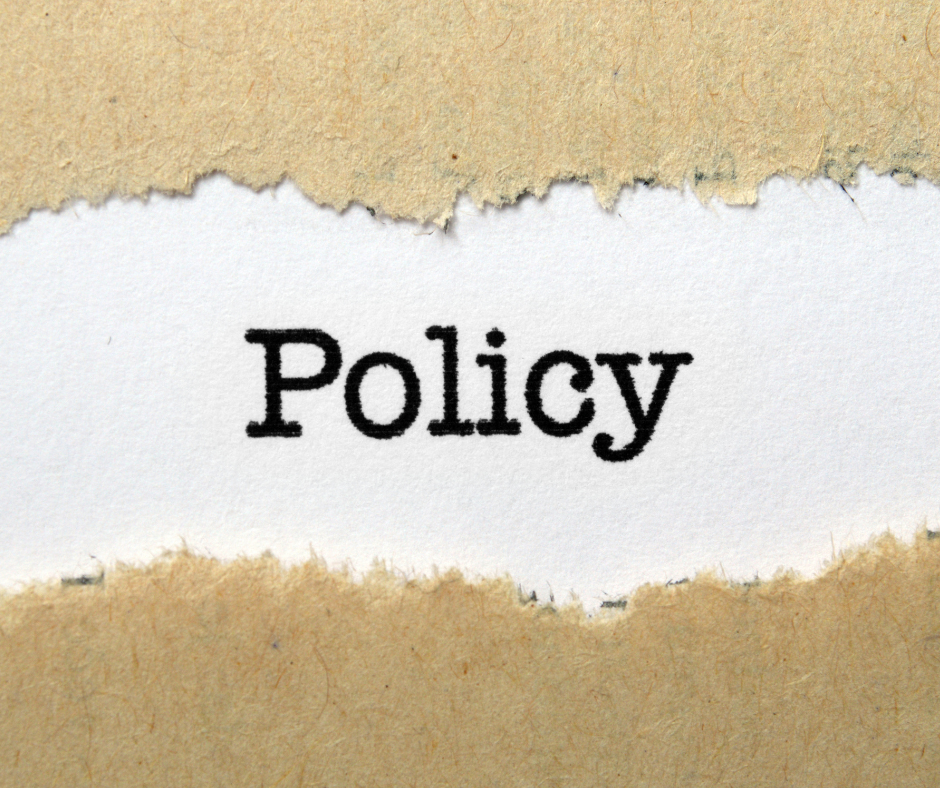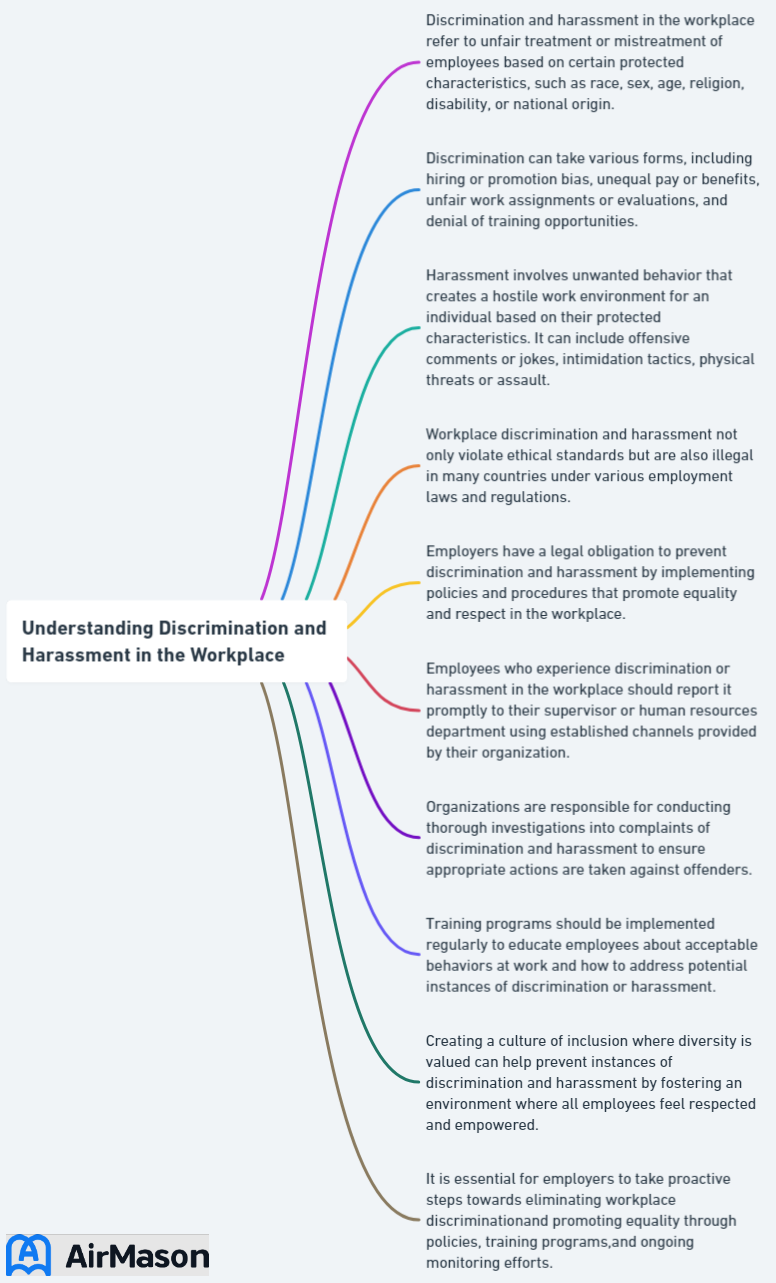
In today’s diverse workforce, understanding discrimination and harassment in the workplace is crucial. These harmful actions can lead to a toxic work environment, affecting employee morale, productivity, and even their mental health. Are you aware of the various forms of discrimination and harassment and the legal framework addressing them? This blog post will provide a comprehensive overview of the different types of discrimination and harassment, relevant federal and state laws, and the responsibilities of both employers and employees in preventing and addressing these issues. Let’s empower ourselves with knowledge to create inclusive, respectful, and harassment-free workplaces for everyone.
Key Takeaways
- Recognizing and addressing discriminatory and harassing behavior in the workplace is essential for a healthy, inclusive environment.
- Employers are responsible for preventing discrimination and harassment with training, policies, investigations, assistance to affected employees & more.
- Employees have legal protections from retaliation when reporting or participating in activities related to discrimination/harassment complaints.
Recognizing Discrimination and Harassment
Discrimination in the workplace occurs when an employer exhibits discriminatory or harassing behavior towards an employee or job applicant due to their membership in a protected group. Workplace harassment is an unacceptable behavior. It can be defined as any unwelcome conduct based on a person’s:
- race
- color
- religion
- sex
- national origin
- older age
- disability
- genetic information
These actions not only create a hostile work environment, but also hinder employees’ well-being and negatively impact their work performance. Maintaining a healthy and inclusive work environment necessitates prompt recognition and addressing of discriminatory and harassing behavior.
Various forms of discrimination and harassment can plague the workplace, including:
- Sexual harassment
- Racial discrimination
- Ethnic discrimination
- Disability-related incidents
The effective identification and addressing of these harmful actions are facilitated by understanding each type.

Sexual Harassment
Sexual harassment encompasses unwelcome sexual advances or requests for sexual favors, as well as offensive comments about someone’s sexuality. It is considered unlawful when it creates a hostile work environment or leads to an adverse employment decision, such as termination or demotion.
Forms of sexual harassment present in the workplace may include:
- Quid pro quo harassment
- Hostile work environment harassment
- Sexual jokes/comments/innuendos
- Unwanted physical conduct, such as touching or advances
- Displaying sexually explicit materials
- Making derogatory/offensive remarks about gender or sexual orientation
Appropriate action can be taken by employees and employers by recognizing these forms.
Racial and Ethnic Harassment
Racial and ethnic harassment involves treating individuals unequally due to their race or national origin, which can be considered as national origin discrimination. Just like other forms of harassment, it creates a hostile work environment and adversely affects employees’ well-being.
Examples of racial and ethnic harassment in the workplace include:
- Racial slurs
- Offensive or derogatory remarks
- Racist jokes, comments, or gestures
- Displays of racially offensive material
- Exclusion or isolation of individuals based on their race
- Verbal threats, insults, or intimidation related to race
The first step towards addressing and preventing racial and ethnic harassment in the workplace is identifying these actions.
Disability Harassment
Disability harassment occurs when employees or applicants are treated unequally due to their physical or mental disabilities or when reasonable accommodations for the disabling condition(s) are not provided. Recognizing disability harassment and understanding the importance of providing reasonable accommodations, as mandated by the Americans with Disabilities Act (ADA) and Rehabilitation Act, is crucial.
Reasonable accommodation refers to the legal obligation of employers to make alterations or modifications to the work environment or job duties that allow individuals with disabilities to carry out their job duties effectively. Providing reasonable accommodations not only guarantees equal opportunities for individuals with disabilities in the workplace but also contributes to creating a more diverse and inclusive workplace, leading to improved productivity and morale.
Discrimination and Harassment in the Workplace
Discrimination and harassment in the workplace are critical issues that demand immediate attention and resolution. Employees have the right to a safe and inclusive work environment, free from any form of discrimination or harassment. Instances of discrimination, such as unequal treatment based on gender, race, age, or religion, can create a hostile workplace and adversely affect an employee’s well-being and performance. Harassment, whether it’s verbal, physical, or psychological, can perpetuate a toxic culture and harm the morale of the workforce. Employers must proactively address these issues through clear policies, thorough training, and a commitment to fostering a culture of respect, equality, and accountability within the organization.
Legal Framework for Addressing Discrimination and Harassment

The legal framework for addressing discrimination and harassment in the workplace comprises federal and state laws designed to safeguard employees from unfair or unwelcome treatment. The EEOC and states are responsible for enforcing these laws. Adhering to these regulations is necessary.
Key federal anti discrimination laws concerning discrimination and harassment include Title VII of the Civil Rights Act of 1964 and the Civil Rights Act of 1991, which forbid discrimination based on race, color, religion, national origin, and sex. In accordance with federal law, state laws, on the other hand, can augment or extend the safeguards provided by these federal laws by encompassing a wider range of protected characteristics, extending protections to smaller employers, providing stronger remedies and enforcement mechanisms, and offering additional protections.
Both employees and employers benefit from understanding the legal framework for addressing discrimination and harassment, as it lays the groundwork for creating inclusive, respectful work environments and ensuring legal compliance.
Federal Laws
Federal laws play a crucial role in protecting employees from discrimination and harassment. Some key federal laws include:
- Title VII of the Civil Rights Act of 1964, which stipulates that discrimination based on sex is not permitted, including sexual harassment
- The Americans with Disabilities Act (ADA), which protects individuals with disabilities from discrimination
- The Age Discrimination in Employment Act (ADEA), which protects employees aged 40 and above from age-based discrimination.
These laws are regulated by the Equal Employment Opportunity Commission (EEOC), which enforces the prohibition of discrimination and harassment based on protected characteristics. In general, federal laws apply to employers with a minimum number of employees, such as 15 for Title VII and the ADA.
Inclusive workplaces that respect the rights of all employees can be created by employers understanding and complying with federal laws, while employees can gain a better understanding of their rights and protections.
State Laws
State and federal law can offer additional protections against workplace discrimination and harassment, which may extend or augment the safeguards provided by federal laws. For instance, the New York State Human Rights Law explicitly prohibits discrimination based on:
- Age
- Race
- Creed
- Color
- National origin
- Sexual orientation
- Military status
- Sex
- Gender identity
- Marital status
- Disability
These protections apply to continued employment and other areas.
In Texas, the Chapter 21 of the Texas Labor Code explicitly prohibits different forms of employment discrimination and outlines harassment as a form of discrimination. In Illinois, additional safeguards against workplace harassment are provided under the Illinois Human Rights Act.
Awareness of relevant state laws can help employees better understand their rights and protections, while enabling employers to ensure legal compliance and foster a respectful, inclusive work environment.
Reporting and Handling Incidents of Discrimination and Harassment

When it comes to reporting and handling incidents of discrimination and harassment, there are various steps employees can take, both internally and externally. Internally, employees can approach their supervisors or human resources departments to report incidents and follow company grievance processes. Externally, employees have the option to file complaints with the EEOC or state civil rights agencies.
Both internal and external reporting processes play essential roles in addressing discrimination and harassment in the workplace. Internal reporting allows employers to rectify any issues promptly, while external reporting helps hold employers accountable for their actions and ensures compliance with the law.
For employees, understanding the options and procedures for reporting discrimination and harassment is crucial, as it enables them to take action and seek justice when faced with unfair treatment at work.
Internal Reporting
Internal reporting procedures typically involve:
- Contacting the individual or department assigned to address grievances
- Providing a comprehensive description of the incident(s)
- Collaborating with any inquiry
- Preserving documentation
- Adhering to any supplementary procedures stipulated by the organization.
Confidentiality and non-retaliation are crucial aspects of the internal reporting process. Employers should take all allegations of harassment seriously, even when the employee requests confidentiality, and ensure that appropriate actions are taken to investigate and address the issue. Employees should be protected from retaliation for reporting discrimination or harassment, as it is their right to be free from such harmful behaviors in the workplace.
External Reporting
In addition to internal reporting, employees can also opt for external reporting by filing complaints with the EEOC or state civil rights agencies. Generally, a complaint must be submitted within 180 calendar days from the date of discrimination, but if the complaint is subject to a state or local anti-discrimination law, the deadline is extended to 300 days.
The potential results of an investigation by the EEOC or state agency may include:
- Conciliation
- Lawsuit filing
- Reasonable cause determination
- Compensatory and punitive damages
- Retaliation protection
Understanding their options for external reporting, employees can ensure their rights are protected and that they have access to legal recourse if necessary.
Harassment Policy at Workplace
A robust harassment policy at the workplace is essential for fostering a safe and inclusive work environment. This policy outlines the organization’s commitment to maintaining a workplace free from any form of harassment, ensuring the well-being and dignity of all employees. It defines what constitutes harassment, whether based on gender, race, ethnicity, religion, or other factors, and provides clear reporting procedures for victims or witnesses. Additionally, the harassment policy at the workplace should articulate the consequences for offenders, emphasizing a zero-tolerance approach towards such misconduct. Regular training and awareness campaigns are also crucial to ensure employees understand the policy and their role in upholding a respectful workplace culture.
Employer Responsibilities in Preventing Discrimination and Harassment

Employers have a responsibility to prevent discrimination and harassment in the workplace. This includes:
- Administering regular, interactive training on sexual harassment prevention
- Establishing a culture that does not condone harassment
- Assessing the organizational climate and potential risks for harassment
- Communicating a policy of zero tolerance for harassment
- Supervising just investigations of grievances
- Enabling employees to be influencers of the company culture.
In fostering a safe and inclusive work environment, it is essential for employers to implement the following preventive measures:
- Training on discrimination and harassment
- Formulating a transparent policy on such issues
- Instituting a reporting system for employees to report occurrences
When allegations of discrimination and harassment arise, employers should undertake a comprehensive inquiry, implement corrective measures as appropriate, and provide assistance to the aggrieved employee. Employers can create a respectful and inclusive workplace for all employees by proactively addressing discrimination and harassment.
Preventive Measures
The occurrence of discrimination and harassment in the workplace can be reduced by implementing preventive measures. Employers should provide training on discrimination and harassment, which not only educates employees on company policies and procedures but also helps them identify and manage biases and promotes cultural proficiency.
Another essential preventive measure is the establishment of clear and transparent policies on discrimination and harassment, along with a reporting system for employees to report occurrences of such behavior. This helps create a safe and supportive environment for employees to voice their concerns and ensures that appropriate actions are taken to address any issues that may arise.
Responding to Complaints
When complaints of discrimination and harassment are reported, employers should respond promptly and effectively. This involves:
- Conducting a comprehensive investigation into the allegations
- Interviewing the parties involved and any witnesses
- Collecting and reviewing relevant documents or evidence
- Maintaining confidentiality throughout the investigation process
- Analyzing the gathered information objectively and impartially
Based on the findings of the investigation, employers should take appropriate corrective action in response to such conduct, such as disciplinary measures or other corrective actions. This may involve suspension or termination, or other measures, including training or alterations to policy.
A respectful and inclusive work environment that values the well-being of all employees can be fostered by employers responding promptly and effectively to complaints.
Employee Rights and Protections Against Retaliation

Employees have the right to be protected against retaliation for reporting discrimination and harassment or participating in related investigations. Retaliation in the workplace is characterized as when an employer takes adverse actions against an employee who has filed a complaint concerning discrimination or harassment.
Examples of retaliation may include termination, relocation to less favorable assignments or shifts, negative evaluations without merit, or an intensification of the original harassment.
Awareness of their rights and the protections available to them in the event of retaliation is essential for employees.
Legal Protections
Employees have various legal protections against retaliation under both federal and state laws. The Equal Employment Opportunity Commission (EEOC) safeguards employees from retaliation by forbidding employers from imposing sanctions on job applicants or employees for asserting their rights to be free from employment discrimination, including harassment.
These legal protections extend to employees who participate in protected activities, such as filing a complaint, testifying, or assisting in an investigation, proceeding, or hearing under any of the EEO laws. When facing retaliation for reporting discrimination or harassment, employees should be aware of their rights and the legal protections available to them.
Recognizing Retaliation
For employees who have reported discrimination or harassment, recognizing signs of retaliation is crucial. Indications of retaliation may include unfair treatment, termination, or other adverse actions taken against the employee as a result of their involvement in protected activity.
Employees who believe they have experienced retaliation have various legal options, such as filing a complaint with the EEOC or state civil rights agencies. Understanding their rights and the legal remedies available can help employees protect themselves and ensure fair and just treatment in the workplace.
Sexual Harassment Policy
A sexual harassment policy is a crucial framework implemented within organizations to address and prevent instances of sexual harassment. This policy sets the standards and guidelines for acceptable behavior and actions, aiming to maintain a safe and respectful work environment for all employees. It clearly defines what constitutes sexual harassment, outlining various forms of unwelcome behaviors, gestures, or actions. Additionally, a sexual harassment policy provides reporting mechanisms and procedures for individuals to report incidents without fear of retaliation. Regular training and awareness programs are often integral components, ensuring employees understand the policy and are equipped to recognize, report, and prevent sexual harassment in the workplace.
Summary
In conclusion, understanding discrimination and harassment in the workplace is vital for creating inclusive, respectful, and harassment-free environments. By recognizing the various forms of discrimination and harassment, familiarizing ourselves with the legal framework, and being aware of our rights and protections, we can contribute to fostering a healthy and diverse workforce. Remember, the responsibility lies not just with employers, but with each one of us to stand against discrimination and harassment and to support our fellow coworkers in their pursuit of a safe and inclusive workplace.
Frequently Asked Questions
What are the three 3 types of harassment?
Verbal, visual, and physical harassment are the three main types of workplace harassment. It is important to be aware of how to prevent and handle these types of situations.
What is an example of discriminatory harassment?
Discriminatory harassment can take the form of epithets, slurs, jokes, negative stereotyping or threats related to a person’s race, color, religion, gender, national origin, age or disability.
What is discrimination and harassment in communication?
Discrimination and harassment in communication is the use of unwanted, unsolicited, unwelcome, repeated, and/or offensive verbal, comments, materials, or behavior directed at another person due to their protected status under the law or Executive Order. This could include name calling, derogatory comments, sexually suggestive comments, offensive language, jokes of a sexual nature, and more.
What counts as discrimination at work?
Employment discrimination occurs when an employer treats an employee or applicant unfavorably because of their race, color, religion, sex, sexual orientation, gender identity, national origin, disability, age (40 or older), or genetic information.
What are some preventive measures employers can take to create a harassment-free workplace?
Employers should provide training on discrimination and harassment, create clear policies, and create a reporting system to promote a safe, harassment-free workplace.